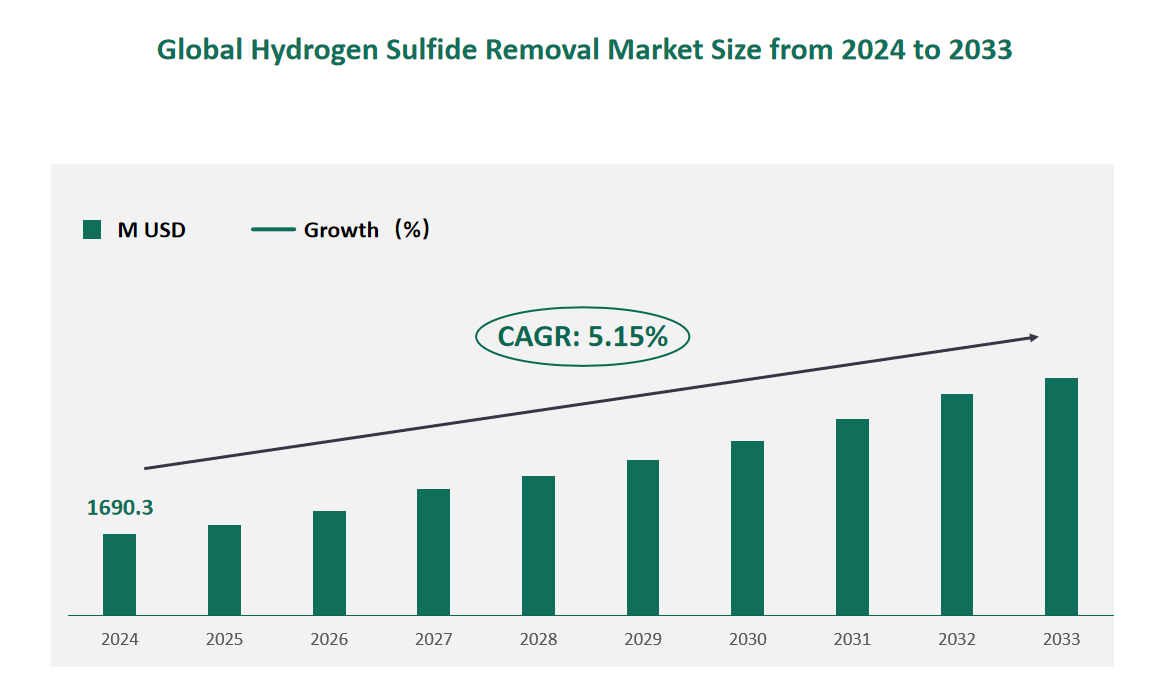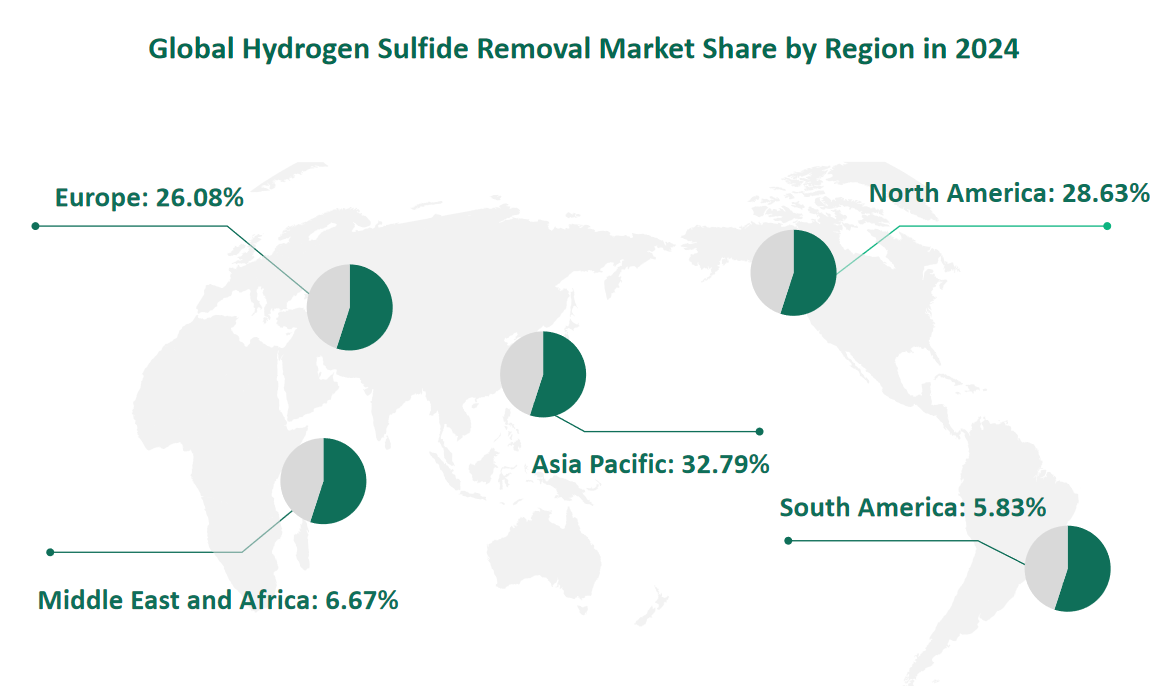1 Global Hydrogen Sulfide Removal Market Size (Value) and CAGR (2024-2033)
In 2024, the global Hydrogen Sulfide Removal market was valued at USD 1690.3 million, with a CAGR of 5.15% from 2024 to 2033.
Hydrogen sulfide removal refers to the application of absorption, adsorption, and catalytic oxidation methods or products to recover, utilize or harmlessly treat hydrogen sulfide (H2S) discharged from industrial production processes. Hydrogen sulfide is produced in natural gas purification, petroleum refining, and production processes such as gas production, tanning, pharmaceuticals, papermaking, and synthetic chemical fibers. Hydrogen sulfide is a colorless gas, has a pungent stench, is volatile, and presents a blue flame when it burns. Hydrogen sulfide is one of the main pollutants in the atmosphere, which not only harms human health, but also severely corrodes equipment.
Figure Global Hydrogen Sulfide Removal Market Size (M USD) and CAGR 2024-2033

2 Hydrogen Sulfide Removal Market Drivers
The Hydrogen Sulfide Removal market is driven by several key opportunities and factors that are propelling its growth. One of the primary drivers is the increasing demand for effective H₂S removal solutions in various industrial sectors, particularly in oil and gas, wastewater treatment, and chemical processing. Hydrogen sulfide is a highly toxic and corrosive gas that poses significant risks to human health and industrial equipment.
Another significant opportunity lies in the continuous development of the chemical industry. Governments and enterprises worldwide are investing heavily in research and development, leading to the innovation of new chemical products and processes. This has resulted in improved production technologies and processes, providing a robust market environment for the growth of the Hydrogen Sulfide Removal industry. The increasing sophistication of equipment manufacturing has also enhanced the efficiency and effectiveness of H₂S removal technologies.
New industry trends are also presenting opportunities for market expansion. There is a growing trend towards reducing total operating costs and minimizing downstream corrosion issues. Non-triazine scavengers, for example, are gaining popularity due to their ability to remove H₂S without the side effects associated with traditional triazine-based products. This trend is encouraging companies to invest in more efficient and environmentally friendly H₂S removal solutions.
3 Hydrogen Sulfide Removal Market Restraints
Despite the significant opportunities, the Hydrogen Sulfide Removal market also faces several challenges and restraints that could impact its growth trajectory. One of the primary challenges is the intense competition within the industry. The market is characterized by a large number of players, leading to fierce competition. Companies must continuously innovate and enhance their products to maintain a competitive edge. Failure to do so could result in a decline in market share and business performance. The entry of new competitors further complicates the market dynamics, making it increasingly difficult for existing players to sustain their positions.
4 Global Hydrogen Sulfide Removal Market Size and Share by Type in 2024
Regenerative Methods are designed to be reusable, making them a cost-effective and sustainable solution for large-scale industrial processes. These methods typically involve the use of absorbents or adsorbents that can capture hydrogen sulfide (H₂S) and then be regenerated through processes such as heating. For example, iron oxide desulfurizers are commonly used in regenerative systems due to their ability to capture H₂S efficiently. Once saturated, these desulfurizers can be regenerated and reused, reducing the overall cost of H₂S removal over time. In 2024, the regenerative segment of the market is expected to be valued at approximately 497.2 M USD. This segment is particularly popular in industries such as oil and gas, where continuous and large-scale H₂S removal is necessary to ensure operational safety and environmental compliance.
Non-Regenerative Methods, on the other hand, involve the use of disposable scavengers and chemicals that react with H₂S to form less harmful byproducts. These methods are often preferred in situations where the volume of H₂S is relatively low or where the cost of regeneration is prohibitive. Non-regenerative methods include the use of triazine-based scavengers, which are effective in neutralizing H₂S but are not reusable. Other chemical agents, such as glyoxal and metal carboxylates, are also used in this segment. In 2024, the non-regenerative segment is projected to be valued at approximately 1193.1 M USD. This segment is characterized by its flexibility and suitability for a wide range of industrial applications, from small-scale operations to large industrial plants.
Table Global Hydrogen Sulfide Removal Market Size and Share by Type in 2024
Type | Market Size (M USD) 2024 | Market Share 2024 |
Regenerative | 497.2 | 29.41% |
Non-Regenerative | 1193.1 | 70.59% |
5 Global Hydrogen Sulfide Removal Market Size and Share by Application in 2024
Gas Industry: The gas industry is one of the primary sectors where hydrogen sulfide removal is essential. Natural gas often contains H₂S, which is highly toxic and corrosive. Effective removal of H₂S ensures the safety of workers and the integrity of equipment. In 2024, the market size for hydrogen sulfide removal in the gas industry is projected to be approximately 714.1 M USD. This segment is driven by the increasing demand for natural gas and the need for compliance with stringent environmental regulations.
Oil Industry: The oil industry also requires significant H₂S removal solutions due to the presence of hydrogen sulfide in crude oil. Effective H₂S removal is crucial for safety, environmental compliance, and the protection of equipment. In 2024, the market size for hydrogen sulfide removal in the oil industry is projected to be approximately 550.6 M USD. This segment is driven by the continuous exploration and production activities in the oil sector.
Wastewater Treatment: Wastewater treatment facilities often encounter hydrogen sulfide, which poses significant environmental and health risks. H₂S removal is essential for maintaining the safety of workers and the surrounding environment. In 2024, the market size for hydrogen sulfide removal in wastewater treatment is projected to be approximately 284.9 M USD. This segment is driven by increasing urbanization and the need for effective wastewater management.
Table Global Hydrogen Sulfide Removal Market Size and Share by Application in 2024
Application | Market Size (M USD) 2024 | Market Share 2024 |
Gas | 714.1 | 42.24% |
Oil | 550.6 | 32.57% |
Waste water Treatment | 284.9 | 16.86% |
Others | 140.8 | 8.33% |
6 Global Hydrogen Sulfide Removal Market Size by Region in 2024
North America: North America is a significant market for hydrogen sulfide removal, driven by the presence of major oil and gas industries and stringent environmental regulations. In 2024, the market size for hydrogen sulfide removal in North America is projected to be approximately 483.9 M USD. The United States and Canada are the primary markets within this region, with significant demand from the oil and gas sectors.
Europe: Europe is another key market, characterized by its advanced industrial infrastructure and strong environmental policies. In 2024, the market size for hydrogen sulfide removal in Europe is projected to be approximately 440.8 M USD. Countries such as Germany, the UK, and France are major contributors to this market, with significant demand from the oil, gas, and wastewater treatment sectors.
Asia-Pacific: The Asia-Pacific region is experiencing rapid growth due to increasing industrialization and urbanization. In 2024, the market size for hydrogen sulfide removal in the Asia-Pacific region is projected to be approximately 554.2 M USD. China, Japan, and India are the primary markets within this region, with significant demand from the oil, gas, and wastewater treatment sectors. The growth in this region is driven by the increasing demand for cleaner industrial processes and environmental compliance.
Figure Global Hydrogen Sulfide Removal Market Share by Region in 2024

7 Major Players in Global Hydrogen Sulfide Removal Market
7.1 Schlumberger
Company Profile: Schlumberger, also known as Schlumberger Limited, is a leading oil services company with a global presence. Established in 1926, the company is headquartered in the United States and operates worldwide. Schlumberger provides a wide range of services, including technology, project management, and information solutions to the international petroleum industry.
Business Overview: Schlumberger offers advanced acquisition and data processing surveys, making it a key player in the oil and gas sector. The company’s diverse portfolio includes services for drilling, production, and reservoir management, positioning it as a comprehensive solutions provider in the industry.
Product Offered: Schlumberger’s Hydrogen Sulfide Removal products include SULFATREAT, a granular iron oxide-based hydrogen sulfide adsorbent. This product is effective in removing H₂S from various gaseous streams and is used in applications ranging from upstream natural gas processing to wastewater treatment.
Recent Financial Data: In the most recent year, Schlumberger’s Hydrogen Sulfide Removal sales reached 73.0 K tons, with a revenue of 136.6 M USD.
7.2 Dow
Company Profile: Dow Inc. is a global chemical company with a diverse portfolio of products and services. Established in 1897, Dow is headquartered in the United States and operates worldwide. The company is known for its innovative solutions in the chemical industry, serving various sectors including architecture, textiles, automobiles, and food.
Business Overview: Dow produces and distributes chemical products for liquid injection molding, architecture fabrication, leather, textiles, automobiles, rubber consumer goods, and food industries. The company’s focus on innovation and sustainability has helped it maintain a strong market presence.
Product Offered: Dow’s Hydrogen Sulfide Removal products include ABATE™ S-200 Scavenger, a triazine-based H₂S scavenger. This product is effective in removing hydrogen sulfide from drilling fluids and other industrial applications, ensuring safety and compliance with environmental regulations.
Recent Financial Data: In the most recent year, Dow’s Hydrogen Sulfide Removal sales reached 63.6 K tons, with a revenue of 115.3 M USD.
7.3 SUEZ Water Technologies & Solutions
Company Profile: SUEZ Water Technologies & Solutions is a leading water treatment company with a global presence. Established in 1969, the company is headquartered in Europe and operates worldwide. SUEZ is known for its comprehensive solutions in water treatment and environmental management.
Business Overview: Suez Water Technologies and Solutions offers a wide range of products and services, including biological treatment, biowaste management, disinfection, electrodialysis, and wastewater treatment chemicals. The company’s focus on sustainable solutions has positioned it as a key player in the water treatment industry.
Product Offered: SUEZ’s Hydrogen Sulfide Removal products include ProSweet H₂S Scavenger Solutions, which are designed to address water-related odor problems caused by hydrogen sulfide and other volatile compounds. These solutions are effective in various industrial applications, including wastewater treatment and odor control.
Recent Financial Data: In the most recent year, SUEZ Water Technologies & Solutions’ Hydrogen Sulfide Removal sales reached 51.9 K tons, with a revenue of 101.8 M USD.

